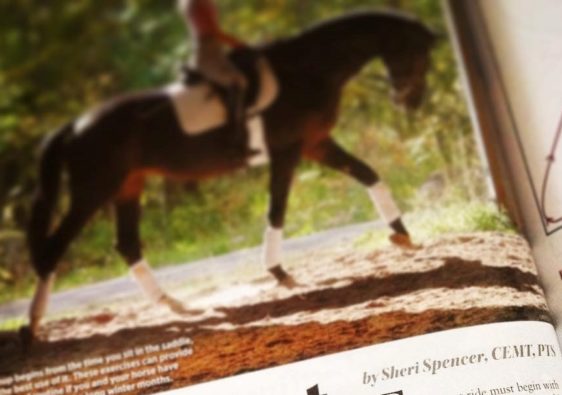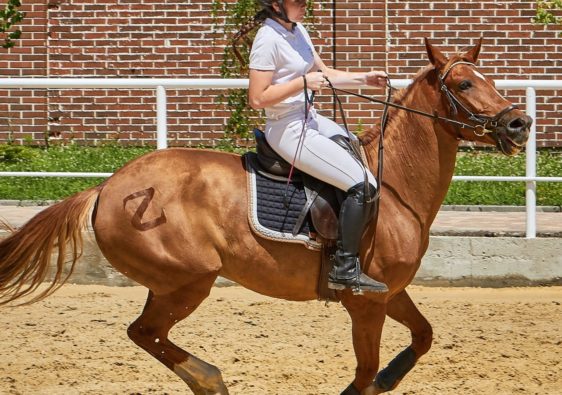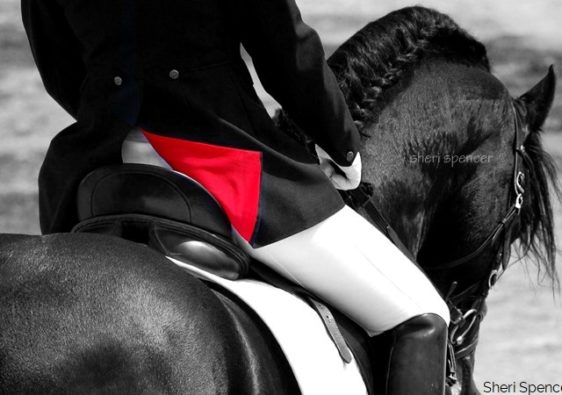To aid in the development of a better, more-balanced canter make the first stride a good one.
For best results with this exercise, it is important to have a good warm-up and a forward, active trot established. On a twenty metre circle at the trot, spiral inward to a 15 or 10 metre circle (small enough for each individual to create a solid bend and earn longitudinal release over the topline without losing balance or forward energy). Stay on that circle until you get a stretch and release through the horse’s body. To encourage the release, ask for bend with the inside leg each time the outside shoulder is forward, and it will stimulate the horse’s inside hind to step under more. As you do this, support the outside shoulder and hip with your outside leg (and hand: as a wall, not a weight). Your inside rein should be soft with elastic connection.
If the horse is reluctant to give, do not circle more than three or four times otherwise it gets boring for the horse and it is simply making a pattern out of the stiffness (while straining them on a tight circle!). Instead, lower your expectations long enough to be happy with a slight flexion through the body, neck OR jaw. Sometimes we reach a deadlock when the horse is stiff, and often GIVING your hands forward an inch or two is enough to allow the horse to reach into the flexion and stretch himself out, but keep the rhythm consistent.
Once the horse has yielded to the bend (but not more than four small circles), spiral out again and try to make it the same number of revolutions as it took to reach the small circle, but stay inside the track of the circle…
As you approach the base of your circle (A or C), leg yield out onto the track those final steps. Half-halt on the outside shoulder (as it goes forward) while asking the inside hind to come under more with your inside leg and then immediately ask for the canter during the moment of suspension. Remember, the canter starts on the outside hind, so cue it while it is airborne for best results.
The first stride might feel like a little jump if he goes into the canter directly off the outside hind (which is good – this is what you want!), so stay with him, keep your lower leg on and your reins elastic. Keep a slight inside bend with your inside leg and each time the shoulder lifts, give a little squeeze for the first few strides to elevate the front. Too much repetition with the lower leg will dullen the horse, so once you get a lighter more cadenced canter, keep your legs present but quiet. As soon as (or if) you feel the canter start to string out, squeeze and half-halt as he lifts the shoulders. Essentially, that movement with your own body will feel similar to how you ask him to come back from a lengthen on each stride, with your legs on. Gather with your legs and seat, support with the outside rein if needed and keep the inside rein soft.
If your horse rushes is trot rather than departing into a canter, regulate his rhythm, balance, and try again. Take your time! The exercise is most beneficial when it is clean. So focus on accuracy – in yourself, too – and establish your balanced trot, create the bend with inner hind engagement, and practice your timing. While this is a general rule of thumb, some horses insist on being different. Pay attention to what you do and what gets results and be consistent. Good luck!
After 3/4 or a full circle with a gathered canter, stop the canter motion with your seat and come back to a trot. Put your leg on to keep an active uphill trot, leg yield off the track, then straighten (which, on a circle is re-establishing the bend of your track), and leg yield back onto the circle and repeat the exercise. Improving the transition and the first strides will build better muscle and awareness in the horse for a better canter.
Starting off, staying on a circle at the canter will help keep them together and build up to maintaining a more collected canter for longer periods of time. Once you have done your first canter depart, you shouldn’t need to spiral all they way in again until the change of direction (where you should keep workouts balanced in both directions). But if the canter gets too strung out that accentuating the lift of the shoulder is not gathering him up, come back to the trot, spiral in while steadying the rhythm, spiral out, half-halt, activate and canter.
Remember to keep it simple (but not monotonous), and stop while you and your horse are both still enthusiastic and motivated, ending the exercise on a positive note. This is challenging work so do remember to reward with a loose trot down the long side, and not be too obsessed with perfecting things! A little step in the right direction goes a long way.



